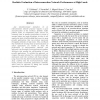Free Online Productivity Tools
i2Speak
i2Symbol
i2OCR
iTex2Img
iWeb2Print
iWeb2Shot
i2Type
iPdf2Split
iPdf2Merge
i2Bopomofo
i2Arabic
i2Style
i2Image
i2PDF
iLatex2Rtf
Sci2ools
101
click to vote
PDCAT
2007
Springer
2007
Springer
Realistic Evaluation of Interconnection Network Performance at High Loads
Any simulation-based evaluation of an interconnection network proposal requires a good characterization of the workload. Synthetic traffic patterns based on independent traffic sources are commonly used to measure performance in terms of average latency and peak throughput. As they do not capture the level of self-throttling that occurs in most parallel applications, they can produce inaccurate throughput estimates at high loads. Thus, workloads that resemble the varying levels of synchronization of actual applications are needed to study the performance of interconnection networks. One approach is to use simple, burst-synchronized synthetic workloads that emulate the self-throttling of many parallel applications. To validate this approach, we compare the gains achieved by a restrictive injection mechanism under this workload with those obtained using traces from the NAS Parallel Benchmarks. This study confirms that the burst-synchronized traffic model provides reasonable performance ...
Distributed And Parallel Computing | Interconnection Network Proposal | Interconnection Networks | Parallel Applications | PDCAT 2007 |
Related Content
| Added | 09 Jun 2010 |
| Updated | 09 Jun 2010 |
| Type | Conference |
| Year | 2007 |
| Where | PDCAT |
| Authors | Francisco Javier Ridruejo Perez, Javier Navaridas, José Miguel-Alonso, Cruz Izu |
Comments (0)

